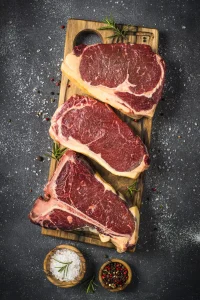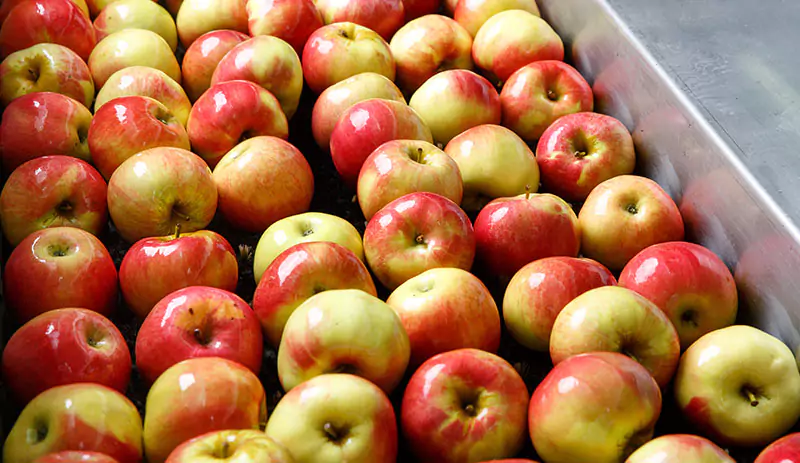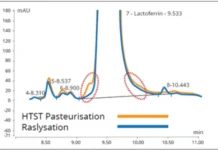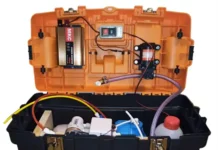IUVA Food and Beverage Safety Working Group
Peter E. Gordon VP of sales and marketing, Cudoform Inc.
Keith Warriner professor of food microbiology, University of Guelph
Mahdiyeh Hasani post-doctoral research fellow, University of Guelph
 Global meat consumption increased 40% in 2020 compared to 2019. This is a staggering statistic, a rare area of economic expansion during the pandemic business contraction. Although meat substitutes appear to be gaining inroads into the market due to a concerted effort to associate meat production with global temperature rise and the advent of vegetable-based, near-meat substitutes for consumer heart health, the reality is that the global value of the meat sector is a $1.2T business, with forecasted increase of 8% over the next five years. Any deviation from this trajectory is a tough sell; meat executives are growing fat on people’s appetite for burgers and steaks.
Global meat consumption increased 40% in 2020 compared to 2019. This is a staggering statistic, a rare area of economic expansion during the pandemic business contraction. Although meat substitutes appear to be gaining inroads into the market due to a concerted effort to associate meat production with global temperature rise and the advent of vegetable-based, near-meat substitutes for consumer heart health, the reality is that the global value of the meat sector is a $1.2T business, with forecasted increase of 8% over the next five years. Any deviation from this trajectory is a tough sell; meat executives are growing fat on people’s appetite for burgers and steaks.
Taking out the pathogens
When food safety experts and technology providers contemplate UV-C equipment deployment opportunities in the meat processing sector, the top applications that come to mind are air disinfection systems to minimize the dissemination of pathogens throughout the facility and to directly decontaminate the meat surface. Decontaminating meat surfaces is challenging due to pathogens such as E. coli and Salmonella residing in protective, shaded sites such as pits, follicles and folds.
Ultimately, the decontamination efficacy is limited to <1 log CFU, but the use of LP lamp 254 nm-based equipment can be boosted by using UV in combination with hydrogen peroxide and ozone (process referred to as gas phase Advanced Oxidation Process or Reactive Trioxidane Process (RTP). In studies performed to date, it has been demonstrated that RTP can support >3 log (>99.9%) reduction. Demonstrations showcase the process is rapid (30s exposure times) and water-free, while leaving no harmful residuals. It is a healthy technical choice.
Extending the shelf life
In addition to a large-scale pathogen reduction step, UV-C LED technologies have been shown to safely extend the shelf life of individual meat selections during transport, storage and chilled displays. Specifically, the ability of UV-C LEDs to operate under refrigerated conditions with negligible heat generation is an attractive characteristic. Some medium-term trials using UV-C LED illuminated meat have demonstrated extended shelf life due to restricting growth of spoilage microbes with no negative quality effects, provided over-dosing (high-intensity, over-extended periods) is prevented. Supermarkets can realize the economic benefits without accidentally barbecuing their products in doing so.
Looking good
If UV-C LED technology cannot be applied due to design complications that may lead to exposure risks of customers and staff, visible LEDs also are finding utility as an alternative in retail displays to preserve the color and quality of meat. Visible LEDs in the red range also have been demonstrated to preserve the color of meat compared to the more traditional white light-emitting fluorescent lamp. In the world of lighting, the intensity delivered in the visible LED spectrum is referred to as Kelvin Color Temperature, which described the warmness of color.
Experiments have shown the optimal level for meat to be a relatively low Kelvin Color Temperature of 3,500K – which equates to soft white light with a degree of redness – as opposed to high Kelvin Color Temperature (for example, 6,500K), which is associated with bright white light with a blue tone. Clearly, meat needs to be tenderly treated to appease the aesthetic sensitivities of consumers who may be rubbed the wrong way knowing their patties are being irradiated. It may take a combination of UV-C LED and red LEDs to find the perfect blend of efficacy and visual acceptance.
Taking the guesswork out of the ‘best before’ dates
The extension of beef shelf life goes a long way to reducing food waste in the meat sector. However, the main cause of food waste is related to products going beyond the “best before” date. Regulations mandate that, as with all perishable products, meat packs need to be stamped with a “best before” date label. Commonly, an arbitrary five days is designated; although it has little scientific basis. The reality is that the spoilage of meat occurs at different rates depending upon microbial loading, presence of specific spoilage organisms and ultimate pH, among other factors.
Upon reaching the “best before” date, the retailer has the option of diverting the product to be incorporated into a value-added line (for example, pre-prepared marinated products), relegating it to the discount bin or, in some cases, changing the date. A better approach is to have a quick, nondestructive, on-site test that can report on the quality of meat along with predicting how many days are left on the shelf-life clock. Among the promising techniques is spectral analysis collected using select LEDs emitting at 405, 430, 505, 660 and 740 nm, then processing the resulting excitations using multispectral image analysis. Such techniques are quickly coming online since the cost savings over spectroscopic techniques are immediate.
The future is bright
Looking further beyond the current reliance on germicidal lamps, perhaps a mixing of wavelengths could be done to micro-adjust shelf life in the future. One set of wavelengths can be utilized to safeguard the meat, while another set pinpoints the last sell-by date so retailers can finely adjust placement and inventory levels. This could have a significant financial impact on a $1.2T business, greatly cutting loss.
The IUVA Food and Beverage Safety Working Group explores the latest updates on the science-based validation and commercialization of UV-C technology for plant growth stimulation or suppression, nutrition enhancement, fungicide and pesticide reduction, wash water sanitation and postharvest disinfection, as well as use for nonthermal, low UVT beverage treatment.
Contact: Peter E. Gordon, [email protected]; Keith Warriner, [email protected]; Mahdiyeh Hasani, [email protected]





